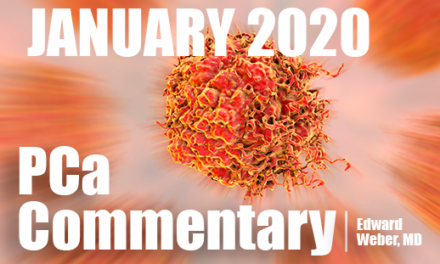
PCa Commentary | Volume 139 – October 2019
Posted by Edward Weber | October 2019
OLIGOMETASTATIC PROSTATE CANCER: Is It an Intermediate Stage of Cancer, and If So, How Should It Be treated?
It has been suggested that a few (usually 3-5, i.e., ‘oligometastatic’) lesions at the time of biochemical failure after primary treatment might represent an indolent disease state with limited potential for additional spread. This hypothesis was first made in 1995 by Hellman and Weichselbaum (J Clin Oncol). Those authors’ thoughts were paraphrased by Tran and Antonarakis (J Oncol Pract. 2016) in “Altering the Natural History of Oligometastatic Prostate Cancer with Local Therapies: Reality Versus Illusion.”
“… the oligometastatic state is juxtaposed at an intermediate position along the spectrum of cancer progression where local therapies may not only alter their natural history, but also cure men with this metastatic disease state.”
However, there has been and continues to be a lack of a detailed characterization of the biology and genomic features of the ‘oligometastatic’ state which would establish it as molecularly distinct. An effort is underway to gain this understanding through grants to 16 research sites from the Movember Global Action Plan 6. This information would become the basis of clinical practice. Lacking genomic guidance, research has proceeded in observational and phase II trials on the basis of imaging.
Definition and prevalence of ’oligometastatic’ prostate cancer:
From Antonarakis (ibid): “… a clinical diagnosis based on up to five radiographically visible metastatic lesions is a reasonable definition,” although in some studies three or fewer lesions were stipulated. Most reported studies were based on imaging with conventional CT and bone scans, although future imaging will likely be done with the more sensitive PSMA and Axumin PET techniques.
From Antonarakis (ibid): “… oligorecurrent (oligoprogressive) prostate cancer comprises a large number of men, possibly the majority of men after failed primary therapy.”
In support of this estimate is the report by DeBruycker et al. based on F-18 choline PET of 208 asymptomatic men with biochemical recurrence after primary therapy: “Prevalence and prognosis of low-volume, oligorecurrent hormone-sensitive prostate cancer amenable to lesion ablative therapy” (BJU Int. 2017 Dec).
- Median PSA at imaging was 3.7 ng/mL.
- Recurrence by site: lymph nodes (pelvic or extra-pelvic), 30%; bone, 18%; prostate or prostate bed, 11%; viscera, 4%; combinations, 37%.
- Patients with <3 metastatic sites (with or without local prostate recurrence) were considered to have low-volume prostate cancer at recurrence.
Their conclusion: “Three out of four patients with PCa with F-18 choline PET-CT-detected recurrence have low-volume disease, potentially amenable to local therapy.”
The biology of metastases supports the early treatment of hormone-sensitive oligometastatic disease:
Two points argue in favor of early treatment. In the past, metastases were thought to be continuously seeded in a one-way outflow from the primary tumor. The current understanding is that tumor cells ping-pong back and forth between metastases and the primary tumor. Additionally, metastatic sites can seed cancer to other sites. Secondly, in the course of treatment of CRPC and metastatic CRPC, mutations develop that spawn resistance not established early on.
“Surveillance or Metastatic-Directed Therapy for Oligometastatic Prostate Cancer Recurrence:
A Prospective Randomized Multicenter Phase II Trial” — Ost et al., J Clin Oncol. Feb 2018.”
In this small trial of MDT, androgen deprivation therapy (ADT) was initiated only upon disease progression. Sixty-two men were randomized 1:1 after a pre-treatment F-18 choline PET/CT recorded three or fewer extracranial metastases. They were located in pelvic and extra-pelvic nodes (55% in each arm) and in bone (range between 36-42%). Median follow-up was 3 years; median time from diagnosis to study, ~4-5 years. A negative MRI of the prostate or prostate bed was required at entry.
Treatment consisted of surgical removal or hypofractionated radiation to each site at a total dose of 30 Gy divided into three separated fractions. PSA testing occurred every 3 months. PSA progression was not an indication to start ADT, but rather was a prompt to re-scan.
Disease progression was determined upon symptom development, new radiographic lesions, or enlargement by >20% of any of the initial tumor sites. PSA progression was called at a PSA increase of >25%.
Findings:
In the MDT arm, the ADT progression-free period was 21 months vs.13 for surveillance.
Three out of four men in the MDT arm showed a PSA decline.
The median time to PSA progression was 10 months for MDT vs. 6 months for surveillance.
No grade 2 or higher toxicity was seen in the MDT cohort and grade 1 toxicity occurred in 17% of men.
“30% of patients treated with MDT progressed to polymetastatic disease within the first year.” Consideration is being given to adding a short course of ADT along with MDT.
A Phase III trial is planned based on information gained in this Phase II trial.
Just reported in abstract form: “Primary Outcomes of a Phase II Randomized Trial of Observation versus Stereotactic Ablative Radiation of Oligometastatic Prostate Cancer (ORIOLE)” ASTRO 2019, abstract LBA3
This Johns Hopkins trial of 54 men was of very similar design as the Ost trial (see above) with very similar early results, i.e. at 6 months, 19% progression in the SABR arm vs. 61% for observation.
The abstract mentioned two findings of special significance:
- An analysis of circulating DNA “identified a specific mutational signature that predicted which men most benefited from SABR.
- An immunologic response was recorded in the SABR cohort in the form of an increase in activated T-cells. Presumably this was a result of the exposure of neo-antigens resulting from radiation-induced cell death.
MDT therapy versus standard-of-care treatment:
It is appropriate to add the caveat as expressed by Clement et al., J. Oncol. Jan 2017, in their review, “Evolving Treatment of Oligometastatic Hormone Sensitive Prostate Cancer”:
“At this time [and now] androgen-deprivation therapy is the backbone of therapy of oligometastatic disease. The addition of local ablative therapy to the prostate, if intact, and/or to systemic metastatic disease to augment or delay androgen deprivation therapy as part of a treatment plan for oligometastatic disease is not standard therapy, although it may well be considered in well-informed men who have demonstrated a limited burden of disease [i.e. 3 – 5 lesions] defined by CT of the abdomen and pelvis and bone scan.” [Likely at the current time to be defined by the Axumin or PSMA PET/CT scans.]
BOTTOM LINE:
The ablative treatment of hormone-sensitive oligometastatic prostate cancer at biochemical progression extends progression-free survival compared to observation only and allows deferment of androgen suppressive therapy. Whether MDT (with or without associated ADT) can provide a survival benefit compared to standard androgen suppression therapy awaits further clinical trials.
Your comments and requests for information on a specific topic are welcome e-mail ecweber@nwlink.com.
Please also visit https://prostatecancerfree.org/prostate-cancer-news for a selection of past issues of the PCa Commentary covering a variety of topics.
“I want to thank Dawn Scott, Staffperson, Tumor Institute Radiation Oncology Group, & Mike Scully, Librarian, Swedish Medical Center for their unfailing, timely, and resourceful support of the Commentary project. Without their help this Commentary would not be possible.”
ABOUT THE AUTHOR
Edward Weber, MD, is a retired medical oncologist living in Seattle, Washington. He was born and raised in a suburb of Reading, Pennsylvania. After graduating from Princeton University in 1956 with a BA in History, Dr. Weber attended medical school at the University of Pennsylvania. His internship training took place at the University of Vermont in Burlington.
A tour of service as a Naval Flight Surgeon positioned him on Whidbey Island, Washington, and this introduction to the Pacific Northwest ultimately proved irresistible. Following naval service, he received postgraduate training in internal medicine in Philadelphia at the Pennsylvania Hospital and then pursued a fellowship in hematology and oncology at the University of Washington.
His career in medical oncology was at the Tumor Institute of the Swedish Hospital in Seattle where his practice focused largely on the treatment of patients experiencing lung, breast, colon, and genitourinary cancer and malignant lymphoma.
Toward the end of his career, he developed a particular concentration on the treatment of prostate cancer. Since retirement in 2002, he has authored the PCa Commentary, published by the Prostate Cancer Treatment Research Foundation, an analysis of new developments in the prostate cancer field with essays discussing and evaluating treatment management options in this disease. He is a regular speaker at various prostate cancer support groups around Seattle.




